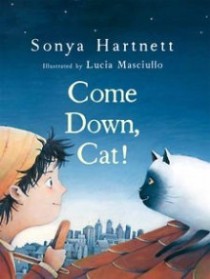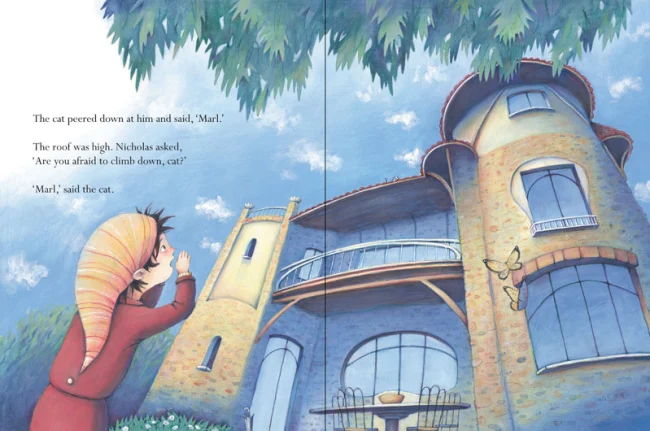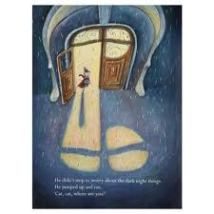Visual elements are an integral part of children’s literature. As picture books are widely used with children, it is important to consider the impact or purpose of the illustrations that accompany stories. Winch, Johnston, March, Ljungdahl and Holliday (2010) discuss how the visual components of a book carry “meaning and power” which in turn can “manipulate certain viewings and certain reactions” (p. 632). Stafford (2010) further explains that pictures that are carefully matched with the words of a story, allow the reader to engage or be moved in ways that might not have been possible without illustrations.
One strong example of effective visual elements within children’s literature is Come down, cat! (Harnett, 2011). This book tells the tale of a cat who will not come down off a roof. His owner, Nicholas is concerned about his cat and what it might be subjected to whilst on its own at night. To start, the front cover of the book shows Nicholas and his cat face-to-face; both smiling; and looking each other in the eye. This suggests the connection the two have. The reader is likely to look at this and conclude Nicholas and his cat are friends.
Image sourced from http://www.sonyahartnett.com.au
Throughout the text, there is a unique use of angles to portray different parts of the story. For example, in the opening of the story where Nicholas is encouraging his cat to come down from the roof, the illustrator, Lucia Masciullo, has included pictures looking up to the house, the roof and the cat. This appears to exaggerate the size of the house and therefore the danger the cat is in. The strategy of perspective encourages the viewer to think and feel a certain way (Winch et al., 2010). Later in the book, when Nicholas is no longer scared of the dangers of the roof, but more worried about rescuing his scared cat, the view is the opposite. It appears the reader is looking down from the roof. This shift of perspective complements the change in storyline.
Image sourced from http://www.penguin.com.au/products/9780670074754/come-down-cat
Image sourced from http://www.larrypost.com.au/books/puffin-children-s-books/sonya-hartnett/come-down-cat.html
The portion of the story that talks about the “dark strange things” in the night; and the “scratchy, scratchy sounds” (Hartnett, 2011), is emphasised through the use of dark gloomy colours. The objects within the picture also appear to have over-emphasised shadows which adds to the ominousness of the story.
Finally, the visual element of Come down, cat!, which is potentially the most critical or interesting is the part in which the text says “she’d see a ghost wafting over the fence. She’d see a monster with a crumpled-up face” (Hartnett, 2011). The author has used these words to describe to horrible things Nicholas’s cat might face up on the roof at night. However the illustrations take this further by showing an outline of a white owl and pictures of bats. Without these pictures, the reader would not know that this is referring to these two animals and it could change the story into one with much more of a fantasy element than is intended.
References
Hartnett, S. (2011). Come down, cat! Melbourne, VIC: Penguin Australia.
Stafford, T. (2011). Teaching visual literacy in the primary classroom. New York, NY: Taylor and Francis Group.
Winch, G., Johnston, R., March, P., Ljungdahl, L., & Holliday, M. (2010). Literacy: Reading, writing and children’s literature (4th ed.). South Melbourne, VIC: Oxford University Press.



Hi Kristy and thanks for your blog.
You have identified well some of the visual elements incorporated in this text and have provided well-considered examples and analyses. of these. You have supported your work well with relevant literature, although I would like to see you move away from direct quoting and paraphrase instead. Proofread your work carefully Kristy as there are errors in punctuation which need to be corrected, especially your use of semi colons. Well done on your referencing.
Wendy
🙂